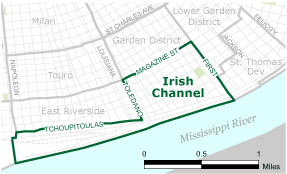
Home ![]() Pre Katrina Home
Pre Katrina Home ![]() Articles
Articles ![]() Change in the Irish Channel
Change in the Irish Channel

Change in the Irish Channel
Thirty years of data about a historic
New Orleans neighborhood
New Orleans
neighborhoods are rich with history – and rife with change. Are you
working to effect change in a New Orleans neighborhood? Read this powerful
story about the Irish Channel for inspiration on historical information
you can pull together to support your work.
![]()
| by Allison Plyer & Denice Warren Ross |
March 17, 2004 | “Nothing stays static,” says Cecelia Husing. And as a long time Irish Channel resident, she should know. She’s seen her neighborhood through enormous change. When change is inevitable, the right set of information can give you important clues about the best way to steer future change in a positive direction.
Neighborhood change from multiple perspectives
The following story about the Irish Channel illustrates the power of combining different perspectives toward a more complete understanding of neighborhood change dynamics.
If you're examining change in the neighborhood in which you work or live, consider gathering information from these perspectives:
- current data (including comparisons to the city or region)
- historical data (comparing it to trends in the larger city or region)
- experts' opinions, and
- residents' insights and explanations.
2000 data about the Irish Channel
|
|
||
|
The Irish Channel neighorhood
has different boundaries depending on who's talking about it and
for what purpose. For looking at Census information, we combined
data for the 3 Census tracts in the area. This geography roughly
matches that of the Historic District, but not exactly.(The "panhandle"
to the left is industrial and not residential.) |
More diverse than many New Orleans neighborhoods, the Irish Channel has 69% Black residents, 30% White, and 4% who are ethnically Hispanic (Census 2000). The neighborhood suffers from a poverty rate (41%) higher than the city as a whole (28%), with a higher than average percentage of families headed by single moms (61% compared to 50% for Orleans), and employment centered mostly around service jobs (29% of workers vs 22% for Orleans).
Looking at historical data
But to understand a neighborhood, we must look at more than just “slice-in-time” data. The Irish Channel is no longer the working class Irish neighborhood it was at its founding in the 1840s. To understand its evolution, we took a look at Census data as far back as 1970. To really flesh out these numbers, we sought out a long-time community resident who could give us a better feel for the impact of the changes in the Irish Channel.
In 1970, the Census reported that the Irish Channel was a predominantly White and working class neighborhood (CensusCD Neighborhood Change Database). With 62% White residents and 38% Black residents, the Irish Channel had a greater percentage of White residents than the city as a whole (Orleans was 55% White and 45% Black). At that time, the poverty rate in the Irish Channel (27%) was the same as the city as a whole (26%). And the percent of families that were female-headed (24%) was also about the same as that of New Orleans (25%). The great majority of employment was blue-collar (for example, 33% of workers were laborers vs 20% in Orleans).
Changes in the data since 1970
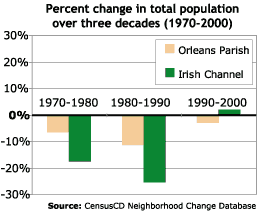 The
changes in the Irish Channel since the 1970s have been dramatic. The total
number of residents has declined 36% since 1970, from 6,692 persons to
its current size of 4,257. The rate of population loss of the Irish Channel
far exceeded the decline in population in New Orleans as a whole (the
city lost 19% of its population from 1970 to 2000). Most of the drop in
the Irish Channel population took place between 1970 and 1990 (down 38%).
In fact, since 1990, the population of the Irish Channel has actually
increased (up 2%).
The
changes in the Irish Channel since the 1970s have been dramatic. The total
number of residents has declined 36% since 1970, from 6,692 persons to
its current size of 4,257. The rate of population loss of the Irish Channel
far exceeded the decline in population in New Orleans as a whole (the
city lost 19% of its population from 1970 to 2000). Most of the drop in
the Irish Channel population took place between 1970 and 1990 (down 38%).
In fact, since 1990, the population of the Irish Channel has actually
increased (up 2%).
We asked Peter Tatian, an expert in neighborhood change with the National Neighborhood Indicators Partnership at the Urban Institute in Washington D.C., to compare what was happening in the Irish Channel to other urban areas across the country.
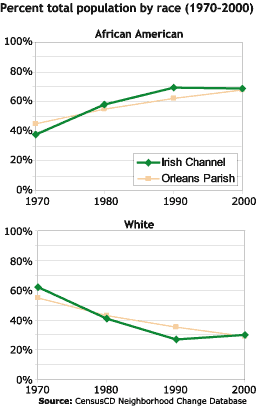 He
notes that “the decline in population in the Irish Channel is consistent
with what was seen in many urban neighborhoods during the past 30 years.
The central cities of major metropolitan areas, like New Orleans, experienced
large populations losses in the 1970s and 1980s, but in the 1990s these
cities began to bounce back.” Mr. Tatian also comments that, “predominantly
Black neighborhoods tended to do worse in the 1990s than other neighborhoods,
so it is quite interesting that the Irish Channel is bucking that trend
by showing signs of population recovery.”
He
notes that “the decline in population in the Irish Channel is consistent
with what was seen in many urban neighborhoods during the past 30 years.
The central cities of major metropolitan areas, like New Orleans, experienced
large populations losses in the 1970s and 1980s, but in the 1990s these
cities began to bounce back.” Mr. Tatian also comments that, “predominantly
Black neighborhoods tended to do worse in the 1990s than other neighborhoods,
so it is quite interesting that the Irish Channel is bucking that trend
by showing signs of population recovery.”
The 1980s
Cecelia Husing, a caterer by trade and community activist by avocation, has lived in the Irish Channel since 1983. The city in general was still benefiting from the oil boom when Ms. Husing bought her house in the Irish Channel and moved in with her teenage son and her toddler. She loved the diversity of the neighborhood and her toddler thrived playing with their new neighbors at the playground down the street.
She explains, “But then in the mid 80s came the oil bust and the crack epidemic. Drug trafficking started moving into our neighborhood little by little. Turf wars began and kids started getting murdered. One 17-year-old boy died right at my feet in front of my house and I couldn’t do anything for him. I can’t tell you how many kids I saw die.
“Twenty years ago, my next-door neighbors left the neighborhood out of fear. She was pregnant and he wanted her out of harm’s way. They couldn't sell their house, so they abandoned it and let it go into foreclosure. By 1990 there were five crack houses on my block alone. We would hear gunshots every day and night. I couldn’t sell my house and I couldn’t rent it for enough to cover the mortgage. We were stuck. I would come home from work everyday and cry for thirty minutes. Then I’d wipe my tears and start dinner.”
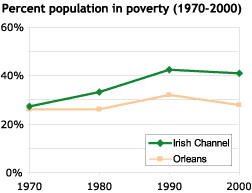 The
1990s
The
1990s
By 1990 the poverty rate in the Irish Channel had reached 43% (higher than the rate of 32% in Orleans as a whole). On this data, Mr. Tatian observes that “while the Irish Channel was apparently not an affluent neighborhood before, it crossed into what we consider the ‘extreme poverty’ range (over 40% poor) between 1980 and 1990.”
Change gonna come
But around 1994, Ms. Husing and some of her neighbors gathered their courage and decided to act. Delivery vans would come into the neighborhood in the middle of the day to buy drugs. She and her neighbors would write down their license plate number and send a postcard to the company telling them that their delivery person stopped in her neighborhood on a particular date and time and bought drugs. “That stopped that,” she said. “Postcards are particularly effective because everybody reads them on their way to the addressed party.”
Shortly after that, a new Police Superintendent was named which meant the head of the district police station also changed. Ms. Husing recalls their first neighborhood association meeting with the new district head. “It was in a church and everyone came. The Section 8 renters and the middle class people in the big houses. Everyone. And everyone was mad as hell about the crime. I’ll never forget my neighbor, a little old lady, walking up the aisle shaking a big jar full of bullet shells, saying, ‘I picked up all these from the sidewalk in front of my house.’
“The police responded. They formed a task force and began to give our neighborhood the same attention they gave to the Garden District across Magazine street. Also, at my request, a sergeant met with me, and we went to the crack house across the street. People were squatting there in the worst conditions you can possibly imagine. It was 6:00 am and the policeman told those people they had to be out by 6:00 pm or he was going to arrest them. One guy started to give him some lip, so he arrested that guy on the spot. The rest of the people spent the day moving their stuff out in grocery carts. That policeman and I cleared out all five dilapidated houses on my block within a couple of months.”
Gentrification
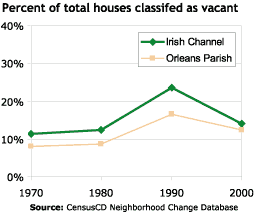 |
In 1990, 1 in 4 Irish Channel houses was vacant. By the late 1990s, things were turning around in the neighborhood. Ms. Husing points out that change has been happening with incredible speed. “The houses that weren’t torn down are being purchased and renovated. And the people who own section 8 rentals are doing renovations for higher-paying tenants. My neighbors, little old Black ladies, are saying ‘Used to be I couldn’t give my house away. I can’t believe how much it’s worth now!’”
Mr. Tatian notes, “With the revival of urban areas, gentrification has become a greater concern for residents of many low income neighborhoods. To be sure, gentrification brings with it many benefits – new investment in the neighborhood, increased homeownership, appreciation of property values, and new residents who can add vitality to the community. But, as housing costs rise from increasing demand, existing residents can find it more difficult to afford to remain in the neighborhood. There are steps that can be taken to deal with these concerns, but it is vital that the city government and neighborhood residents work together toward balancing those issues.”
![]()
|
Want information on New Orleans neighborhoods? At the Community Data Center web site (www.gnocdc.org), you can find lots of information on all 73 neighborhoods in the City of New Orleans. If you want to learn more about the Irish Channel neighborhood, you'll find snapshots of the history and culture of the Irish Channel and also data including demographics, income, transportation and more. If you're with a local nonprofit or community based organization and would like assistance gathering historical data for the neighborhood you work in, Ask Allison. |
This article is a collaboration between the Greater New Orleans Community Data Center and the National Neighborhood Indicators Partnership at the Urban Institute in Washington DC. Allison Plyer is the Research Manager and Denice Ross is the Information Systems Designer at the Data Center. Maps and graphs created by Joy Bonaguro, the Data Center's Web and Data Production Coordinator. Photograph of the double shotgun house courtesy of the Preservation Resource Center.
About
the Neighborhood Change Database...
The CensusCD
Neighborhood Change Database (NCDB) was created by the Urban Institute
and GeoLytics, Inc. with funding from the Rockefeller Foundation. This
data resource is designed to enable policy makers, community organizations,
and researchers to examine and analyze changes that have occurred in U.S.
neighborhoods over the past three decades. The NCDB combines tract-level
data from the 1970 - 2000 decennial censuses into one easy-to-use product,
and is literally the only source of census data with variables and tract
boundaries that are consistently defined across census years. Learn more
about this resource
from the Urban Institute, or, if you're working in the New Orleans
area, use our Ask Allison feature to
request data over time for the neighborhood you serve.
Home ![]() Pre Katrina Home
Pre Katrina Home ![]() Articles
Articles ![]() Change in the Irish Channel
Change in the Irish Channel
![]()
|
Greater New Orleans Community Data Center
Last modified: March 17, 2004 |
